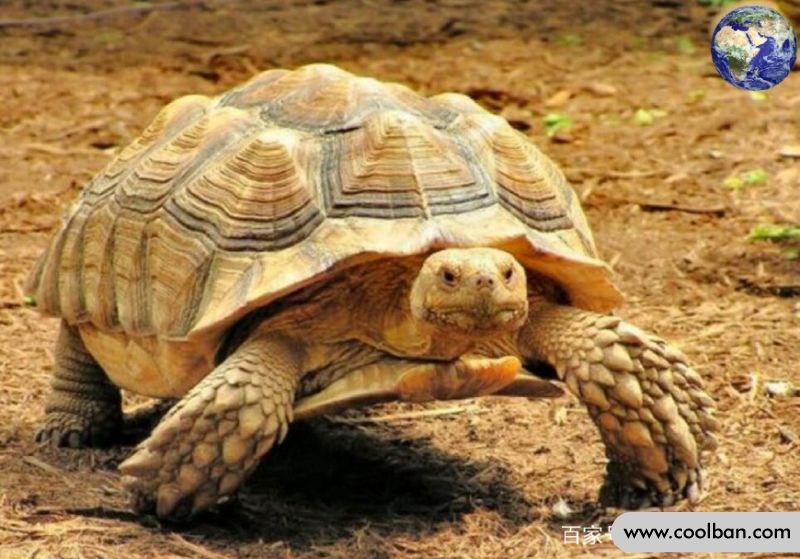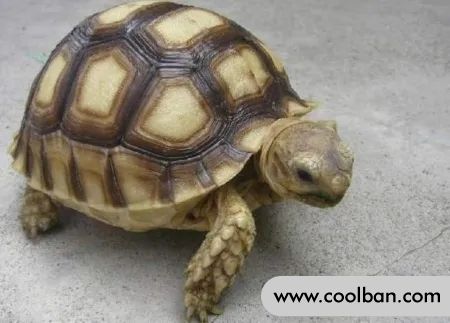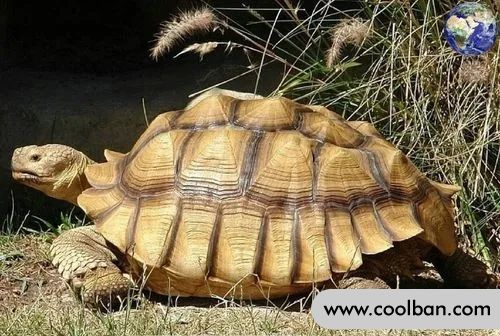How to feed Sulcata tortoises?
2022-08-19
The wild number and resources of Sulcata tortoises are scarce, but there are many artificially bred individuals, and it is not difficult to buy them in the market. Generally, the price varies greatly according to individual body type. Native to the Sahara Desert, Sahel region and West African desert steppe, mainly distributed in Chad, Eritrea, Ethiopia, Mali, Mauritania, Nigeria, Senegal, Sudan.
The Sulcata tortoise is probably the most distinctive tortoise. Apart from the unexpected surprise of the president, there are no special patterns on the carapace of the Sulcata tortoise, and the color is relatively simple. Even so, Sulcata tortoises are quite endearing.
Appearance characteristics of the Sulcata tortoise
The appearance of the Sulcata tortoise is similar to that of the leopard tortoise, but the carapace has no fancy decorations and is almost pure bright brown (including the entire head, limbs and plastron). The throat carapace is prominent, the anterior and posterior border shields of some male adults are obviously curled, and there are several conical granular scales on the back of the thigh. They are the third largest turtle in the world. In the wilderness, males may grow to 75 cm and can weigh up to 100 kg. The captured su may be smaller, 60cm long and 50~90kg in weight. Sexual maturity is generally between 25 and 30 reached around age. It is difficult to distinguish the gender correctly until it grows to 50~60cm.

Body shape change and rearing space
Due to its rapid growth rate and final size, Sulcata tortoises are not recommended for novice rearing in winter climates. The space for indoor breeding must be 60cm*60cm, but this size will change within two years, because it is not unusual for a Sulcata tortoise to grow to 30cm in three years, and the space after adulthood is 240*240cm, so it is not possible to raise it indoors. practical.
Generally speaking, the size of the turtle body has a great relationship with the price. Of course, the smaller the cheaper the cheaper, but Sulcata tortoises are prone to illness when they are young, so it is recommended to buy a larger one within an acceptable price range.
Sulcata tortoise breeding knowledge
1. Selection of substrates in the environment
The best substrate for summer is newspaper, as sulcata tortoises are dirty. It will start to smell like stables. Due to their large excretion, the droppings of even hatchlings less than 30 cm long can rival that of adult turtles. Therefore, cleaning under it with newspaper is a good way to keep the turtle healthy as well. Do not use newspapers in winter. If heated, the white weave lamp plus the temperature required by Suka plus the newspaper will easily catch fire. A piece of wood is best as a base material, this piece of wood can be bumpy depending on how you do it yourself. You can put water in the sinking pit. The rearing box must be absolutely ventilated and can generally be dry. Hay can also be used as a substrate. One is easy to maintain, and the other is that it does not matter if eaten by mistake, and it also contains cellulose nutrition.

2. Sulcata tortoise sunlight needs
If outdoor sunlight is not provided, you will need to equip your turtle with fluorescent full-spectrum UVB lamps and warming bulbs and should always be provided from hatching to adulthood. Sunlight through glass or windows cannot provide these UVBs Rays. The most common window glass filters out all beneficial light, including UVB. UVB is an animal produced vitamin D3 Necessary for healthy shell growth and to aid calcium absorption. Remember that all so called "full spectrum" don't provide UVB Light, sunshine is always the best. It is wise to consider the combined use of full spectrum lights and natural sunlight. This turtle needs a lot of sunlight every day for a long time, so you have to be ready for the winter UVB lights for emergencies.
3. Control of feed temperature
In the layout of the breeding site, the temperature during the day should be 28~32°C, and there is a drying point temperature of 35~38°C. The night temperature should be 24~26℃. This is a desert-type animal, adapted to hot, dry climates. But the temperature should not exceed 40 ℃. When it's too hot, they pour cold sand on their shells and secrete a lot of saliva, which they smear on their forearms to cool off. However, basking in the sun is its best source of heat. But you want to make sure the temperature of your overhead heat source is not too hot for the size of your terrarium. So the thermostat is especially important. Generally, heat lamps and heating pads will be comfortable.

4. Food Requirements for Sulcata tortoises
Sulcata's diet consists primarily of kale, mustard, dandelion, and high-fiber grasses similar to dark green lettuce. They eat a variety of fruits such as carrots, melons, apples, beans, peas, apricots, peaches and strawberries. Do not feed lettuce, tomatoes, cucumbers, cabbage, broccoli, cauliflower, bok choy, or rhubarb. Those high fiber foods are an absolute must for the sulcata tortoise and are good for the turtle's growth and stomach. Vitamins and crushed eggshells or crushed oysters (found in turtle food) need to be added to their diet once a week. Leave the cuttlefish bones in the nest and they will chew on it for calcium.
5. Precautions for feeding Sulcata tortoises
It is advisable to treat the Sulcata tortoise as a cow, feed it all the food the cow eats, and raise it as if it were grazing. The feeding time of the Sulcata tortoise can be from morning to evening, continuous feeding. Turtles can usually rely on water in their food to maintain adequate hydration in their bodies. Furthermore, due to their own adaptation to the production environment, Sulcata tortoises can survive even with little water. But to make sure they have the right amount of water in their bodies, it's best to give them a weekly bath.
The Sulcata tortoise is probably the most distinctive tortoise. Apart from the unexpected surprise of the president, there are no special patterns on the carapace of the Sulcata tortoise, and the color is relatively simple. Even so, Sulcata tortoises are quite endearing.
Appearance characteristics of the Sulcata tortoise
The appearance of the Sulcata tortoise is similar to that of the leopard tortoise, but the carapace has no fancy decorations and is almost pure bright brown (including the entire head, limbs and plastron). The throat carapace is prominent, the anterior and posterior border shields of some male adults are obviously curled, and there are several conical granular scales on the back of the thigh. They are the third largest turtle in the world. In the wilderness, males may grow to 75 cm and can weigh up to 100 kg. The captured su may be smaller, 60cm long and 50~90kg in weight. Sexual maturity is generally between 25 and 30 reached around age. It is difficult to distinguish the gender correctly until it grows to 50~60cm.

Body shape change and rearing space
Due to its rapid growth rate and final size, Sulcata tortoises are not recommended for novice rearing in winter climates. The space for indoor breeding must be 60cm*60cm, but this size will change within two years, because it is not unusual for a Sulcata tortoise to grow to 30cm in three years, and the space after adulthood is 240*240cm, so it is not possible to raise it indoors. practical.
Generally speaking, the size of the turtle body has a great relationship with the price. Of course, the smaller the cheaper the cheaper, but Sulcata tortoises are prone to illness when they are young, so it is recommended to buy a larger one within an acceptable price range.
Sulcata tortoise breeding knowledge
1. Selection of substrates in the environment
The best substrate for summer is newspaper, as sulcata tortoises are dirty. It will start to smell like stables. Due to their large excretion, the droppings of even hatchlings less than 30 cm long can rival that of adult turtles. Therefore, cleaning under it with newspaper is a good way to keep the turtle healthy as well. Do not use newspapers in winter. If heated, the white weave lamp plus the temperature required by Suka plus the newspaper will easily catch fire. A piece of wood is best as a base material, this piece of wood can be bumpy depending on how you do it yourself. You can put water in the sinking pit. The rearing box must be absolutely ventilated and can generally be dry. Hay can also be used as a substrate. One is easy to maintain, and the other is that it does not matter if eaten by mistake, and it also contains cellulose nutrition.

2. Sulcata tortoise sunlight needs
If outdoor sunlight is not provided, you will need to equip your turtle with fluorescent full-spectrum UVB lamps and warming bulbs and should always be provided from hatching to adulthood. Sunlight through glass or windows cannot provide these UVBs Rays. The most common window glass filters out all beneficial light, including UVB. UVB is an animal produced vitamin D3 Necessary for healthy shell growth and to aid calcium absorption. Remember that all so called "full spectrum" don't provide UVB Light, sunshine is always the best. It is wise to consider the combined use of full spectrum lights and natural sunlight. This turtle needs a lot of sunlight every day for a long time, so you have to be ready for the winter UVB lights for emergencies.
3. Control of feed temperature
In the layout of the breeding site, the temperature during the day should be 28~32°C, and there is a drying point temperature of 35~38°C. The night temperature should be 24~26℃. This is a desert-type animal, adapted to hot, dry climates. But the temperature should not exceed 40 ℃. When it's too hot, they pour cold sand on their shells and secrete a lot of saliva, which they smear on their forearms to cool off. However, basking in the sun is its best source of heat. But you want to make sure the temperature of your overhead heat source is not too hot for the size of your terrarium. So the thermostat is especially important. Generally, heat lamps and heating pads will be comfortable.

4. Food Requirements for Sulcata tortoises
Sulcata's diet consists primarily of kale, mustard, dandelion, and high-fiber grasses similar to dark green lettuce. They eat a variety of fruits such as carrots, melons, apples, beans, peas, apricots, peaches and strawberries. Do not feed lettuce, tomatoes, cucumbers, cabbage, broccoli, cauliflower, bok choy, or rhubarb. Those high fiber foods are an absolute must for the sulcata tortoise and are good for the turtle's growth and stomach. Vitamins and crushed eggshells or crushed oysters (found in turtle food) need to be added to their diet once a week. Leave the cuttlefish bones in the nest and they will chew on it for calcium.
5. Precautions for feeding Sulcata tortoises
It is advisable to treat the Sulcata tortoise as a cow, feed it all the food the cow eats, and raise it as if it were grazing. The feeding time of the Sulcata tortoise can be from morning to evening, continuous feeding. Turtles can usually rely on water in their food to maintain adequate hydration in their bodies. Furthermore, due to their own adaptation to the production environment, Sulcata tortoises can survive even with little water. But to make sure they have the right amount of water in their bodies, it's best to give them a weekly bath.
